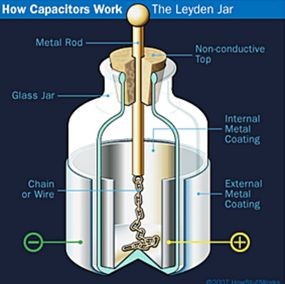The invention of the capacitor is a topic with varying perspectives. Historical records indicate that Ewald Georg von Kleist, a German scientist, conceived the idea of a capacitor in November 1745. However, several months later, Pieter van Musschenbroek, a Dutch professor at the University of Leyden, developed a very similar device known as the Leyden jar. The Leyden jar is often credited as the first capacitor. While Kleist lacked detailed documentation and the same level of recognition as his Dutch counterpart, both scientists are now acknowledged for their independent research and contributions to the capacitor’s evolution.
 Leyden jar capacitor invented by Pieter van Musschenbroek
Leyden jar capacitor invented by Pieter van Musschenbroek
The Leyden jar, recognized as the original capacitor, was invented by Pieter van Musschenbroek at the University of Leyden.
The Leyden Jar: A Primitive Capacitor
The Leyden jar was a relatively simple apparatus. It consisted of a glass jar, approximately half-filled with water, with its interior and exterior surfaces lined with metal foil. The glass served as the dielectric, although it was initially believed that water was the essential component. A metal wire or chain was typically inserted through a cork in the jar’s opening. This chain would then be connected to a source of charge, frequently a hand-cranked static generator. Upon charging, the jar would accumulate two equal but opposite charges in equilibrium. Connecting these charges with a wire would then produce a small spark or shock, demonstrating the capacitor’s ability to store electrical energy.
From Leyden Jars to Flat Capacitors
Benjamin Franklin’s experiments with electricity involved the use of the Leyden jar. He soon discovered that a flat piece of glass could perform the same function as the jar model, leading him to invent the flat capacitor, also known as the Franklin square.
Years later, Michael Faraday, an English chemist, pioneered the first practical applications for the capacitor. He aimed to store unused electrons from his experiments. This endeavor resulted in the creation of the first usable capacitor, constructed from large oil barrels.
Michael Faraday’s early work on capacitors, utilizing oil barrels, laid the groundwork for modern energy storage solutions.
Faraday’s Legacy: Capacitance and the Farad
Faraday’s progress with capacitors eventually enabled the transmission of electric power over long distances. His achievements in the field of electricity led to the adoption of the farad as the unit of measurement for capacitors, or capacitance, in his honor. The farad quantifies a capacitor’s ability to store electrical charge.
The Modern Capacitor
Today, capacitors are ubiquitous in electronic circuits, playing a vital role in filtering, energy storage, and timing applications. From smartphones to power grids, What Is A Capacitor is more than a simple device; it’s a fundamental building block of modern technology. Their evolution from the Leyden jar to sophisticated multilayer ceramic capacitors highlights their enduring importance in electrical engineering. Understanding the principles of capacitance is therefore crucial for anyone involved in electronics design or repair.